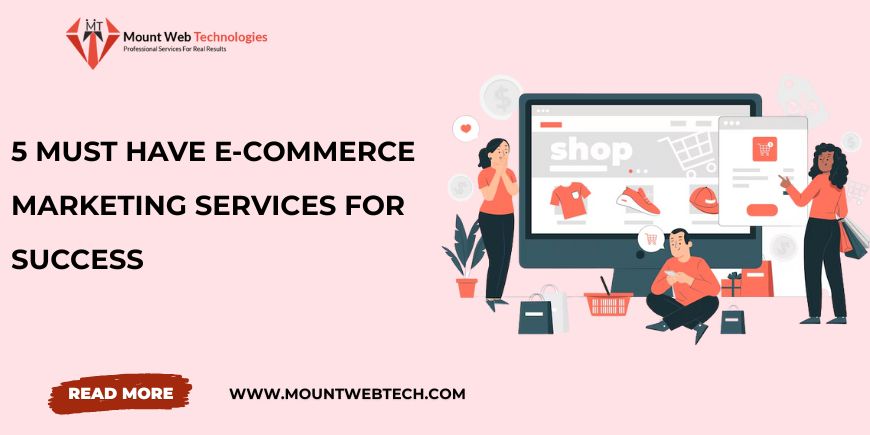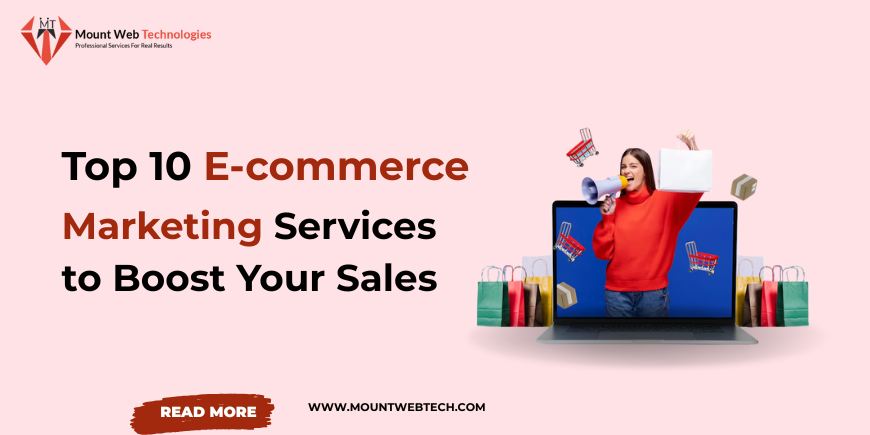5 Must Have E-commerce Marketing Services for Success
Running an online store comes with clear expectations. As a seller, you want E-commerce Marketing Services that deliver more prepaid orders, a steady daily order flow, and a low cost of customer acquisition. However, with competition growing daily, achieving these results requires more than just listing products on a website. According to reports, the e-commerce market of India is expected to reach USD 111 billion by 2027. Such growth is due to digital adoption and mobile-first shopping habits. Along with the growth comes sharper competition, where businesses that lack structured marketing often find it tough to stay profitable. Fortunately, there is a clear solution. In this guide, we’ll look at the top 5 E-commerce Marketing Services. These services can help you boost sales, lower acquisition costs, and achieve long-term growth in the fast-paced online marketplace. Top 5 E-commerce Marketing Services to Drive Growth and Sales 1. Search Engine Optimization (SEO) for Online Stores Search Engine Optimization is the foundation of visibility for any online store. A well-optimized site ensures that shoppers can easily find your products when they search on Google. Instead of relying only on paid ads, SEO builds steady organic traffic that drives long-term results. Effective e-commerce SEO includes: Optimizing product titles, descriptions, and images by keywords relevant to the products Creating category pages that are pleasurable to browse Improvement of speed and responsiveness of the devices being used Backlinks with authority should be built. Local SEO is equally beneficial for stores targeting a particular city or any other region in India. A clothing retailer in Mumbai can target “Buy Cotton Kurta in Mumbai.” This will draw in customers nearby who are ready to buy. With such a strategy, the local shoppers searching for products in their neighborhood will be able to find you and thus faster and genuine sales would result. An investment in structured SEO helps an online store not only with visibility but also with reducing expensive advertising over time. 2. Pay-Per-Click (PPC) Advertising While SEO builds long-term visibility, most e-commerce businesses also need immediate results. That is where Pay-Per-Click (PPC) advertising comes in. Pay-Per-Click (PPC) advertising provides e-commerce stores with instant visibility on platforms such as Google, Meta, and Amazon. Unlike SEO, which requires time, PPC enables you to reach shoppers at the exact moment they are searching for your products. When managed correctly, PPC campaigns lower acquisition costs and deliver steady sales, making it one of the most effective E-commerce marketing services for fast growth. According to Statista, digital ad spending in India is projected to reach USD 9.68 billion by 2025. This highlights how quickly businesses are moving their budgets online. Using the right keywords, like “best headphones under 2000,” helps draw in buyers who are ready to buy. Well-planned PPC campaigns boost sales and offer measurable insights. This lets you adjust bids, creatives, and audiences for the best return on investment. 3. Social Media Marketing & Content Strategy India has more than 467 million social media users and is certainly one of the most profitable online marketplaces. Instagram, Facebook, WhatsApp, and Snapchat provide opportunities for brands to display products, engage with customers, and foster communities. But it doesn’t mean that being engaged in social media is enough to promote real sales. It requires a purposeful content strategy that consistently engages with your target audience. A practical approach to E-commerce Marketing Services on social media begins with identifying the right platforms. Instagram is perfect for showcasing products. Facebook and WhatsApp are excellent for engaging with users personally. Paid advertising expands your reach by targeting buyers based on location, age, and interests. Strong content pillars, such as product showcases, seasonal campaigns, and customer stories, keep the brand voice consistent. At the same time, encouraging user-generated content creates credibility and trust that paid campaigns alone cannot achieve. Here are proven content formats that deliver results: Tutorial, tip, and how-to posts Reviews, testimonials, and behind-the-scenes clips Polls, quizzes, contests, and giveaways Memes, festive campaigns, and launch teasers A content strategy ensures that a single post, story, or campaign is in tune with long-term goals. For example, India’s premier beauty e-commerce brand, Nykaa, works on Instagram not just for promotional activities but also to provide tutorials and skincare tips, thereby keeping followers engaged. Influencer collaborations are equally powerful, often generating up to 11 times higher ROI compared to traditional ads. 4. Email & Marketing Automation Email is still one of the best tools for E-commerce marketing services. The trends have been unstoppable for automation-related technology, making this technique more effective. Where the one-size-fits-all email was once sent to all customers, brands can now indeed target specific groups. By searching through shopping history, browsing activities, and preferences, brands can personalize the communication. This way, it prepares one with an email that feels personalized and thus increases the chance of conversion. Today, there are modern email platforms such as Klaviyo and Mailchimp, permitting retailers to create largely automated workflows, including exemplary cases of abandoned cart workflows, post-purchase follow-ups, or reactivation campaigns. These systems use data-driven triggers that reach customers at the right moment. Automated cart recovery emails can bring back up to 20% of lost sales. This shows how important this service is for online stores. For example: A fashion retailer can create personalized campaigns. These campaigns can remind customers about items in their cart and encourage them to finish their purchase. The most effective campaigns include: Exclusive discounts or limited-time offers Product images that remind shoppers of their interests Clear calls to action with clickable links When executed this way, email and automation not only boost conversions but also nurture loyalty through consistent engagement and relevant updates. 5. Conversion Rate Optimization (CRO) & Analytics Driving traffic to an online store is only half the job; the real success comes when visitors turn into paying customers. That is where Conversion Rate Optimization plays a vital role within E-commerce marketing services. Modern tools, such as chatbots, have become essential in improving conversions by guiding shoppers in real-time. They




